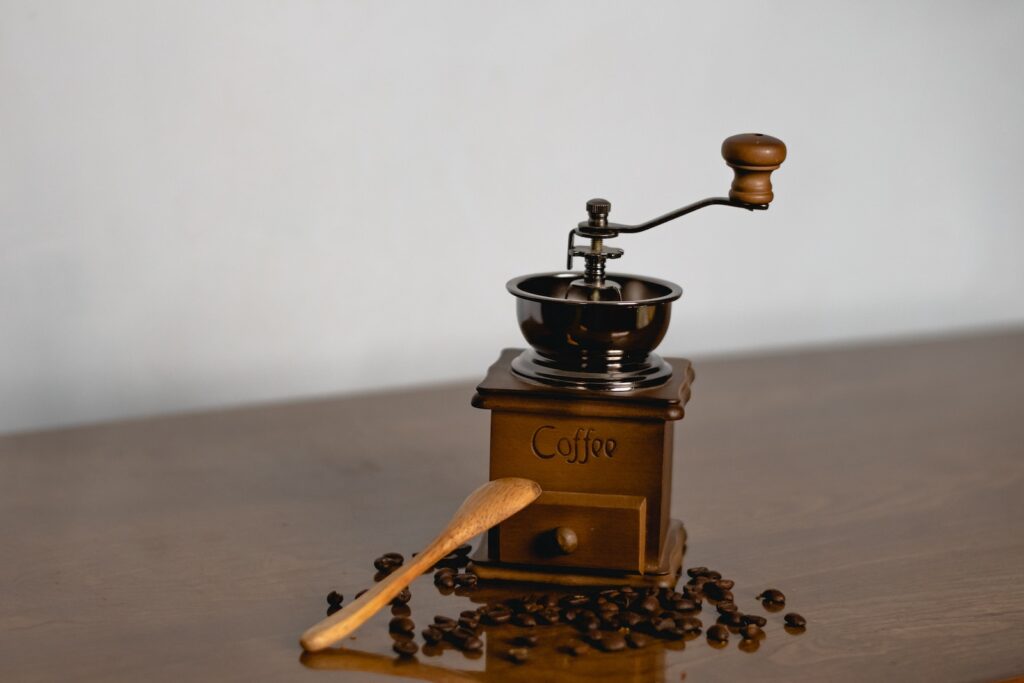Looking to elevate your home brewing game? There’s nothing quite like starting the day with a perfectly brewed cup of coffee, and having the right equipment can make all the difference. One essential piece in any coffee enthusiast’s arsenal is a manual grinder.
Not only do they offer better control over your grind size, but they also allow you to experience the sensory pleasure of manually grinding your own beans.
What are Manual Grinders?

Manual grinders come in all different shapes and sizes; from small, portable hand grinders to massive, stand-alone machines. They all have one common goal – to finely grind your coffee or grinding spices.
If you’re new to manual coffee grinding, there are a few things you need to know. First, don’t use too much pressure when grinding your beans – just tamp them down with the grinder disk until they start to make some noise.
Second, keep an eye on the particle size of your coffee – you want it ground slightly finer than what you would get from a regular drip machine. Finally, be sure to clean your grinder regularly – grit can build up over time and cause problems with performance.
Types of Manual Grinders
There are a few different types of manual grinders depending on the needs of the brewer. The most popular type for home brewers is the coffee mill. This is a device that consists of a metal bowl with a smaller grinder attached to it that spins around, grinding the beans.
Brewers can also use handheld devices like a French press, pour-over brewer and even an electric Burr Mill to grind their own coffee. These devices work by using water pressure to ground the beans, and they come in either manual or automatic models.
Of all the different types of manual grinders, the burr mill is probably the most popular due to its easy operation and versatility. This type of grinder uses spinning disks to crush and grind your beans, and they come in both manual and automatic versions.
Some brewers prefer manual mills because they believe they produce finer-ground coffee than automatic models. Automatic mills are great for people who don’t have time to spend grinding their beans every morning or when they’re short on counter space, but many brewers still prefer mills over machines because they believe that their taste is better.
Pros and Cons of Manual Grinders
The most popular manual grinder for home brewing is the burr grinder. This type of grinder has two plates that rotate around a central axis. The teeth on the plates easily grind beans and other small pieces of plant matter.
One downside to using a burr grinder is that it can be difficult to get the fine dust required for cleaning. Additionally, the teeth can wear down over time, so it’s important to replace them regularly.
Pedal machines are another popular option for manual grinders. These units have a set of pedals that you push in order to grind the beans. They’re generally easier to use than burr grinders, but they don’t produce as much dust and can be less durable.
If you don’t mind spending a little bit more money, then a cone or conical burr grinder is a better choice overall. These units have specially designed teeth that allow you to easily achieve consistent grinding texture and finish.
However, if you plan on using your grinder occasionally but don’t want to invest in something expensive, a manual coffee grinder will do the trick. These types of grinders work just like those used in cafes – they transfer heat from the ground coffee into water in order to create espresso-style drinks.
Manual Grinders for Home Brewing
If you’re looking for a powerful, easy-to-use grinder to help make your homebrewing experience smoother, manual grinders are a great option. In this guide, we’ll outline the different types of manual grinders available on the market and explain their various benefits and drawbacks.
Before we get started, it’s important to note that not all grinders are created equal. To get the most out of your grinder, you’ll need to choose one that’s well-made and fits your needs specifically. That said, here are some general tips to follow when purchasing a manual grinder:
- Make sure the grinder has enough power – Manual grinders don’t have the same level of precision as electric brewers’ blenders, so make sure the model you choose has enough horsepower to get the job done.
- Choose one with variable speed – Some models offer variable speeds that can be adjusted depending on what type of grain you’re grinding. This allows you to customize how finely you want your grains ground.
- Consider the size – You don’t want a grinder that’s too large or too small – find one that’s comfortable for both you and your counter space.
How to Choose the Right Manual Grinder for You
The manual grinder is a versatile tool that can be used for a variety of tasks in the home brewing arsenal. Here are four things to keep in mind when choosing which manual grinder is right for you:
- Size and Weight. First, consider the size and weight of the grinder. If you plan to use it primarily for grinding grain, go for a smaller model that is lighter. If, on the other hand, you plan to use it mainly for coffee or spices, go for a larger model with more weight to give it more stability.
- Durability and Gripping Power. Second, decide if durability and gripping power are important factors for you. Some grinders are built with robust materials that can handle repeated uses well; others are made from lighter materials that may not last as long but offer more grip when using them manually.
- Speed and Ease of Set-Up/Operation. Third, consider how quick and easy the grinder set-up and operation are; this will depend largely on the type of manual grinder you choose. Simplicity is key when it comes to getting started using your new appliance!
- Optimal Grinding Capacity and Recommended Additions. Finally, think about what types of ingredients you’ll be grinding most often—this will help inform whether an optimal capacity or additional features such as dosing meters or timer functions would be beneficial to your needs.
Tips for Keeping Your Manual Grinder in Top Shape
When you are working with your manual grinder, it is important to take care of it. This can be as simple as cleaning the blades and guards on a regular basis, to ensuring that the gears and shafts are still in good condition. Here are a few tips for keeping your manual grinder in top shape:
- Clean the blades and guards on a regular basis – this will keep them running smoothly and prevent any accumulation of debris
- Check the gears and shafts regularly – if they start to show signs of wear, they should be replaced
- Lubricate the moving parts as necessary – this will help them run more smoothly and reduce the chance of corrosion
Conclusion
A manual grinder is a great way to make your own ground coffee, and there are several different types on the market that can suit different needs. If you’re just starting out with home brewing, a burr grinder is a good option because it produces consistently sized grounds.
On the other hand, if you’re someone who likes to grind their coffee fresh every time they drink it, an electronic grinder might be the better choice for you. Regardless of which type of manual grinder you choose, make sure to read the manufacturer’s instructions carefully so that you don’t end up with an unusable machine.



One Comment